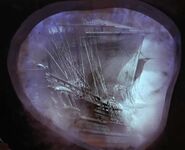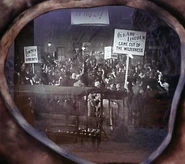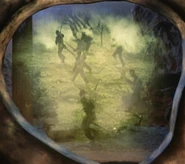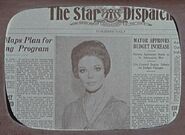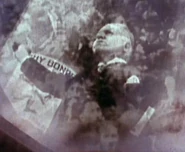FaNbOy1988 (talk | contribs) Tags: VE apiedit |
Tag: sourceedit |
||
| (2 intermediate revisions by 2 users not shown) | |||
| Line 1: | Line 1: | ||
{{at|xx}} |
{{at|xx}} |
||
[[File:Guardian of Forever, 2267.jpg|thumb|The Guardian of Forever in 2267]] |
[[File:Guardian of Forever, 2267.jpg|thumb|The Guardian of Forever in 2267]] |
||
| − | {{aquote|Are you machine or being?"<br />"I am both... and neither. |
+ | {{aquote|Are you machine or being?"<br />"I am both... and neither. I am my own beginning, my own ending.|James T. Kirk''' questioning the '''Guardian of Forever|2267|The City on the Edge of Forever}} |
| − | The '''Guardian of Forever''' was a construct of an unknown, ancient alien race that functioned as a [[time portal]], a gateway to the [[time vortex]] that allowed access to other times and [[dimension|dimensions]]. It was located on an [[Unnamed Alpha and Beta Quadrant planets#Time planet|ancient planet]] where the focus of all [[timeline|timelines]] throughout at least the [[Milky Way Galaxy]] converged. It was apparently sentient, responding to external stimulus such as questions and actions, and could even somehow control the flow of time. It generated immense ripples in time that manifested themselves as spatial disturbances in the region around the planet where it was located. |
+ | The '''Guardian of Forever''' was a construct of an unknown, ancient alien race that functioned as a [[time portal]], a gateway to the [[time vortex]] that allowed access to other times and [[dimension|dimensions]]. It was located on an [[Unnamed Alpha and Beta Quadrant planets#Time planet|ancient planet]] where the focus of all [[timeline|timelines]] throughout at least the [[Milky Way Galaxy]] converged. It was apparently sentient, responding to external stimulus such as questions and actions, and could even somehow control the flow of time. It generated immense ripples in time that manifested themselves as spatial disturbances in the region around the planet where it was located. |
The Guardian is located among the ruins of a large, forgotten city that stretched beyond the horizon in all directions around it. Based on initial observations, the ruins appeared to be at least one million years old. |
The Guardian is located among the ruins of a large, forgotten city that stretched beyond the horizon in all directions around it. Based on initial observations, the ruins appeared to be at least one million years old. |
||
| Line 32: | Line 32: | ||
== Appendices == |
== Appendices == |
||
=== Background information === |
=== Background information === |
||
| − | In the original teleplay for "The City on the Edge of Forever", the Guardians of the Time Vortex were |
+ | In the original teleplay for "The City on the Edge of Forever", the Guardians of the Time Vortex were 9-foot (2.7 meter) tall, humanoid statue-like beings. |
The original Guardian was designed by [[Desilu]] Supervising Art Director [[Rolland M. Brooks]], because his colleague, regular Set Designer [[Matt Jefferies]], was sick with the flu that week. ([[Star Trek: The Animated Series (DVD)|''Star Trek: The Animated Series'' DVDs]] special feature "{{e|Yesteryear}} [[text commentary]]") When Jefferies returned to his duties and saw the lopsided donut-shaped set piece for the first time, he reportedly exclaimed, "''What the hell is this?!''" according to Story Editor [[DC Fontana]]. (''[[These Are the Voyages: TOS Season One]]'', 1st ed, p. 517) Special Effects Artist [[Jim Rugg]] was responsible for the light effects for the Guardian. (''[[Cinefantastique]]'', Vol. 17, No. 2, p. 24) The voice of the Guardian was performed by [[Bart LaRue]] in "The City on the Edge of Forever". |
The original Guardian was designed by [[Desilu]] Supervising Art Director [[Rolland M. Brooks]], because his colleague, regular Set Designer [[Matt Jefferies]], was sick with the flu that week. ([[Star Trek: The Animated Series (DVD)|''Star Trek: The Animated Series'' DVDs]] special feature "{{e|Yesteryear}} [[text commentary]]") When Jefferies returned to his duties and saw the lopsided donut-shaped set piece for the first time, he reportedly exclaimed, "''What the hell is this?!''" according to Story Editor [[DC Fontana]]. (''[[These Are the Voyages: TOS Season One]]'', 1st ed, p. 517) Special Effects Artist [[Jim Rugg]] was responsible for the light effects for the Guardian. (''[[Cinefantastique]]'', Vol. 17, No. 2, p. 24) The voice of the Guardian was performed by [[Bart LaRue]] in "The City on the Edge of Forever". |
||
| − | + | The Guardian's last words in "The City on the Edge of Forever" were: "''Many such journeys are possible. Let me be your gateway.''" Although this suggests that further stories could have been written involving the Guardian of Forever, the Guardian's only other on-screen [[canon]]ical role was in the animated episode "Yesteryear". In that installment, its voice was performed by [[James Doohan]]. |
|
An original draft of the episode that eventually became {{TNG|Yesterday's Enterprise}} featured a Vulcan science team researching history through the Guardian of Forever. In that story, the team accidentally caused the death of [[Surak]], the father of modern Vulcan philosophy – as a result, the [[Time of Awakening]] never occurred, and the Vulcan race had essentially evolved as the [[Romulan]]s. The timeline was reset when [[Sarek]], aboard the ''Enterprise''-D to greet the scientists, used the Guardian to go back in time and take Surak's place in history. (''[[Star Trek: The Next Generation Companion]]'') |
An original draft of the episode that eventually became {{TNG|Yesterday's Enterprise}} featured a Vulcan science team researching history through the Guardian of Forever. In that story, the team accidentally caused the death of [[Surak]], the father of modern Vulcan philosophy – as a result, the [[Time of Awakening]] never occurred, and the Vulcan race had essentially evolved as the [[Romulan]]s. The timeline was reset when [[Sarek]], aboard the ''Enterprise''-D to greet the scientists, used the Guardian to go back in time and take Surak's place in history. (''[[Star Trek: The Next Generation Companion]]'') |
||
During production on the [[Star Trek films|film]] {{film|11}}, it was briefly rumored that the Guardian would be used by the Romulans to go back in time. [http://www.iesb.net/index.php?option=com_content&task=view&id=3696&Itemid=99] |
During production on the [[Star Trek films|film]] {{film|11}}, it was briefly rumored that the Guardian would be used by the Romulans to go back in time. [http://www.iesb.net/index.php?option=com_content&task=view&id=3696&Itemid=99] |
||
| + | [[Category:Individuals]] |
||
| + | [[Category:Time travel]] |
||
=== Apocrypha === |
=== Apocrypha === |
||
The Guardian appears in the game ''[[Star Trek Online]]'' in a mission involving the players character breaking the quarantine of the guardian's planet. The player must travel through the portal in order to follow a group of Klingons and stop them from destroying the Enterprise from the Original series and rescue [[Miral Paris]], who they kidnapped to create and distribute a cure to the [[Klingon augment virus]]. Also, if you question the Guardian about why it speaks in riddles, it explains that it merely answers as simple as the Player Character can understand. |
The Guardian appears in the game ''[[Star Trek Online]]'' in a mission involving the players character breaking the quarantine of the guardian's planet. The player must travel through the portal in order to follow a group of Klingons and stop them from destroying the Enterprise from the Original series and rescue [[Miral Paris]], who they kidnapped to create and distribute a cure to the [[Klingon augment virus]]. Also, if you question the Guardian about why it speaks in riddles, it explains that it merely answers as simple as the Player Character can understand. |
||
| − | In the novel ''[[Yesterday's Son]]'', Kirk and Spock use the Guardian to rescue Spock's son Zar from the ancient, doomed world of [[Sarpeidon]]. |
+ | In the novel ''[[Yesterday's Son]]'', Kirk and Spock use the Guardian to rescue Spock's son Zar from the ancient, doomed world of [[Sarpeidon]]. They also discover that Zar is able to communicate telepathically with the Guardian. In the novel's sequel ''[[Time for Yesterday]]'', the Guardian is summoned away from its duties of regulating time in the Milky Way by its capricious Creators. Zar uses his telepathic powers to return the consciousness of the Guardian to the gateway and banish the Creators to a universe where they cannot harm our space-time. |
In the novel ''[[Engines of Destiny]]'', the Guardian appears in an alternate timeline where the [[Borg]] have conquered Earth and an alternate [[Guinan]], having learned of the change, has gone to the Guardian's planet to ask for help, and the Guardian reveals how to restore the timeline to normal. |
In the novel ''[[Engines of Destiny]]'', the Guardian appears in an alternate timeline where the [[Borg]] have conquered Earth and an alternate [[Guinan]], having learned of the change, has gone to the Guardian's planet to ask for help, and the Guardian reveals how to restore the timeline to normal. |
||
| Line 55: | Line 57: | ||
In the ''[[Star Trek: The Next Generation - Q Continuum (novel series)|Q Continuum]]'' series, the Guardian is used by a younger [[Q]] when attempting to find something new, allowing him to make contact with the being known as [[0]] (although the Guardian briefly tries to deny 0 access to this universe), who subsequently contacts [[Beta XII-A entity|(*)]], [[Gorgan]] and [[God (Sha Ka Ree)|The One]] via the Guardian. It is hinted here that the Guardian was built by the race that would eventually evolve into the Q – when looking at the Guardian, the young Q comments "''At least our ancestors ''made'' things''", reflecting his dejection at the stagnant nature of the Q Continuum – but the veracity of this is uncertain, and given the nature of the Guardian, Q's comments might have been influenced by images he perceived within it. |
In the ''[[Star Trek: The Next Generation - Q Continuum (novel series)|Q Continuum]]'' series, the Guardian is used by a younger [[Q]] when attempting to find something new, allowing him to make contact with the being known as [[0]] (although the Guardian briefly tries to deny 0 access to this universe), who subsequently contacts [[Beta XII-A entity|(*)]], [[Gorgan]] and [[God (Sha Ka Ree)|The One]] via the Guardian. It is hinted here that the Guardian was built by the race that would eventually evolve into the Q – when looking at the Guardian, the young Q comments "''At least our ancestors ''made'' things''", reflecting his dejection at the stagnant nature of the Q Continuum – but the veracity of this is uncertain, and given the nature of the Guardian, Q's comments might have been influenced by images he perceived within it. |
||
| − | In the alternate future seen in the ''[[Star Trek: Deep Space Nine]]'' book trilogy ''[[Star Trek: Deep Space Nine - Millennium|Millennium]]'' the Guardian of Forever was key to Admiral [[Kathryn Janeway]]'s Project Forever. |
+ | In the alternate future seen in the ''[[Star Trek: Deep Space Nine]]'' book trilogy ''[[Star Trek: Deep Space Nine - Millennium|Millennium]]'' the Guardian of Forever was key to Admiral [[Kathryn Janeway]]'s Project Forever. Janeway, along with a combined Federation/Borg armada hoped to use the Guardian to go back in time and wipe out [[Bajor]] (the Federation was at war with the Bajoran Ascendancy in this timeline and were facing the end of the universe). However, at the very moment that Janeway and a team arrived at the Guardian, the Grigari set off a singularity bomb, creating a black hole that destroyed the entire Federation/Borg fleet, the Grigari fleet, Janeway, and the Guardian. The timeline was later reset by [[Benjamin Sisko]] and the crew of [[Deep Space 9]]. |
In the alternate future presented in ''[[Imzadi (novel)|Imzadi]]'', Admiral [[William T. Riker|Riker]] used the Guardian to travel back in time to save [[Deanna Troi]]'s life from an attempt to kill her and prevent her participation in a conference. In the timeline where she died, the species involved went on to secretly rebuild and become a major military power, but with her survival, Troi's empathic powers revealed that they were lying to gain time, and the conference was abandoned until the species was in desperate need of assistance. Although the future [[Data]] also attempts to travel back in time to maintain continuity (Riker is convinced to travel back after new evidence suggests that Troi was killed by a time-traveler, but Data feels that Riker is clutching at straws), it is revealed at the conclusion of the novel that history ''had'' already been changed, and Riker's actions actually set it back on the right path. |
In the alternate future presented in ''[[Imzadi (novel)|Imzadi]]'', Admiral [[William T. Riker|Riker]] used the Guardian to travel back in time to save [[Deanna Troi]]'s life from an attempt to kill her and prevent her participation in a conference. In the timeline where she died, the species involved went on to secretly rebuild and become a major military power, but with her survival, Troi's empathic powers revealed that they were lying to gain time, and the conference was abandoned until the species was in desperate need of assistance. Although the future [[Data]] also attempts to travel back in time to maintain continuity (Riker is convinced to travel back after new evidence suggests that Troi was killed by a time-traveler, but Data feels that Riker is clutching at straws), it is revealed at the conclusion of the novel that history ''had'' already been changed, and Riker's actions actually set it back on the right path. |
||
| Line 61: | Line 63: | ||
In ''[[Spock Vs. Q]]'', Spock mentions having used the Guardian to travel back to the 20th century. Q describes it as "that lop-sided donut thing" before Spock corrects him, and asks him if he knows it. Q responds "''been there, done that, got the T-shirt.''" |
In ''[[Spock Vs. Q]]'', Spock mentions having used the Guardian to travel back to the 20th century. Q describes it as "that lop-sided donut thing" before Spock corrects him, and asks him if he knows it. Q responds "''been there, done that, got the T-shirt.''" |
||
| − | In the novel ''[[Provenance of Shadows]]'', the ''Enterprise'' returns to the Guardian for a third time, just before the end of its original 5-year mission. |
+ | In the novel ''[[Provenance of Shadows]]'', the ''Enterprise'' returns to the Guardian for a third time, just before the end of its original 5-year mission. They respond to a distress call from the science station erected in orbit of the Guardian's planet. Three [[Klingon]] ships attack the station and the ''Enterprise''. They are successful in boarding the ''Enterprise''{{'}}s bridge and manage to take over the ship, forcing the crew to abandon ship, but Captain Kirk manages to escape, obtain several phasers, and transport down to the planet. There, he steps through the Guardian and ends up back on the ''Enterprise''{{'}}s bridge moments before the Klingons boarded. As the crew evacuates the bridge, Kirk sets the phasers on overload, and sacrifices himself to kill the Klingons, but his now-alternate timeline counterpart survives. As a last resort, the Klingons crash their ship into the Guardian, apparently destroying it. |
The image of the sailing ship firing its cannons seen in the Guardian's portal is also later seen in the intro to the [[mirror universe]] episodes of ''[[Star Trek: Enterprise]]''. |
The image of the sailing ship firing its cannons seen in the Guardian's portal is also later seen in the intro to the [[mirror universe]] episodes of ''[[Star Trek: Enterprise]]''. |
||
| Line 67: | Line 69: | ||
A 1978 story in an issue of the [[Gold Key]] Star Trek comic, entitled "[[No Time Like the Past (comic)|No Time Like the Past]]", features the Guardian. |
A 1978 story in an issue of the [[Gold Key]] Star Trek comic, entitled "[[No Time Like the Past (comic)|No Time Like the Past]]", features the Guardian. |
||
| − | In the short story "Guardians" (from the anthology ''[[Strange New Worlds VII]]''), the Horta are assigned by the Federation to serve as the protectors of the Guardian after a failed attack/attempt to alter the timeline by the Romulans. |
+ | In the short story "Guardians" (from the anthology ''[[Strange New Worlds VII]]''), the Horta are assigned by the Federation to serve as the protectors of the Guardian after a failed attack/attempt to alter the timeline by the Romulans. Since their lifespan extends for the next 40,000 years, they are witnesses to vast changes in the Federation, the ascendancy of humanity to incorporeal beings and the eventual exploration of the known universe and beyond. The Guardian undergoes periodic attacks and attempted usage from the [[Borg]], the Romulans and the [[Crystalline Entity]], each time defeated by the Horta. |
The Guardian is also featured in the novel ''[[The Star to Every Wandering]]'', in which it plays a sizeable role. In this novel, the events of the film ''[[Star Trek Generations]]'' play out differently, with Kirk's emergence from the [[Nexus]] resulting in a temporal loop with catastrophic effects. This Kirk, returned to the Nexus by these events, then recruits another version of himself from within the Nexus, who then rescues yet another Kirk from the [[USS Enterprise (NCC-1701-B)]] by employing the Guardian of Forever to travel through time. This third Kirk then travels to [[Veridian III]] and dies helping Picard save the solar system, while the second Kirk ends up contemplating using the Guardian to travel back in time and save [[Edith Keeler]]'s life without damaging history. |
The Guardian is also featured in the novel ''[[The Star to Every Wandering]]'', in which it plays a sizeable role. In this novel, the events of the film ''[[Star Trek Generations]]'' play out differently, with Kirk's emergence from the [[Nexus]] resulting in a temporal loop with catastrophic effects. This Kirk, returned to the Nexus by these events, then recruits another version of himself from within the Nexus, who then rescues yet another Kirk from the [[USS Enterprise (NCC-1701-B)]] by employing the Guardian of Forever to travel through time. This third Kirk then travels to [[Veridian III]] and dies helping Picard save the solar system, while the second Kirk ends up contemplating using the Guardian to travel back in time and save [[Edith Keeler]]'s life without damaging history. |
||
| Line 73: | Line 75: | ||
=== See also === |
=== See also === |
||
* ''[[The City on the Edge of Forever (reference book)|The City on the Edge of Forever]]'', the original story outline and screenplay published by [[Harlan Ellison]] |
* ''[[The City on the Edge of Forever (reference book)|The City on the Edge of Forever]]'', the original story outline and screenplay published by [[Harlan Ellison]] |
||
| − | * The [[Nexus]]: a formless, infinite plane of existence shaped by it's inhabitants' individual desires and dreams; where the rules of the physical universe, such as that of time and space, don't apply. Should anyone wish to leave, they could literally go to ''any'' point in the [[spacetime]] continuum of their choosing. |
+ | * The [[Nexus]]: a formless, infinite plane of existence shaped by it's inhabitants' individual desires and dreams; where the rules of the physical universe, such as that of time and space, don't apply. Should anyone wish to leave, they could literally go to ''any'' point in the [[spacetime]] continuum of their choosing. (''{{film|7}}'') |
=== External link === |
=== External link === |
||
Revision as of 17:27, 6 April 2016
AT: "xx"
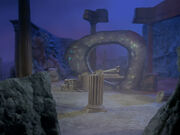
The Guardian of Forever in 2267
"I am both... and neither. I am my own beginning, my own ending."
The Guardian of Forever was a construct of an unknown, ancient alien race that functioned as a time portal, a gateway to the time vortex that allowed access to other times and dimensions. It was located on an ancient planet where the focus of all timelines throughout at least the Milky Way Galaxy converged. It was apparently sentient, responding to external stimulus such as questions and actions, and could even somehow control the flow of time. It generated immense ripples in time that manifested themselves as spatial disturbances in the region around the planet where it was located.
The Guardian is located among the ruins of a large, forgotten city that stretched beyond the horizon in all directions around it. Based on initial observations, the ruins appeared to be at least one million years old.
Capable of speaking to those around it, the Guardian explained that it is "its own beginning and its own ending," and that, "since before your sun (Sol) burned hot in space, [it had] awaited a question." Apparently an inert formation of quasi-metallic substance, the Guardian creates portals to other times.
The Guardian was first discovered by the crew of the USS Enterprise in 2267. Encountering powerful waves of space displacement, which Spock described as "ripples in time," the Enterprise tracked the waves back to their point of origin on a previously-uncharted planet. Doctor McCoy, suffering from paranoid delusions as a result of an accidental overdose of cordrazine, beamed down to the surface in an attempt to escape the ship. Searching for McCoy, Captain Kirk and Spock encountered and made contact with the Guardian, who offered them the chance to explore the past. As the Guardian was displaying images from Earth history, McCoy emerged from hiding and leapt through the time portal, arriving on Earth in the year 1930.
The landing party soon discovered that they had lost all contact with the Enterprise, and the Guardian informed them that McCoy had effected a change in history, wiping out their civilization. Realizing that they must correct the damage to history, Kirk and Spock had the Guardian replay Earth history, and traveled through the portal to a point in time prior to McCoy's arrival. Eventually successful in their effort to restore the timeline, the Guardian returned all three of them to their proper place and time, mere moments after they initially departed. (TOS: "The City on the Edge of Forever")
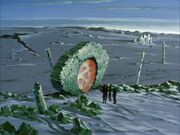
The Guardian in 2269
In 2269, a team of historians, accompanied by Captain Kirk and Spock, used the Guardian to investigate Federation history. Their investigation included firsthand accounts of the formation of the Orion civilization and the monitoring of Vulcan history of the 2230s and 2240s. While Kirk and Spock were visiting Orion, their support team was monitoring Vulcan's past, which, in doing so, inadvertently removed Spock from the proper timeline. Spock, however, was protected from the change while he was in Orion's past, and the change to the timeline went unnoticed until he and Kirk returned through the Guardian. Once the cause was determined, Spock was able to use the Guardian to return to his own childhood on Vulcan, and prevent his death during the kahs-wan ritual. (TAS: "Yesteryear")
Images seen through the Guardian of Forever
Appendices
Background information
In the original teleplay for "The City on the Edge of Forever", the Guardians of the Time Vortex were 9-foot (2.7 meter) tall, humanoid statue-like beings.
The original Guardian was designed by Desilu Supervising Art Director Rolland M. Brooks, because his colleague, regular Set Designer Matt Jefferies, was sick with the flu that week. (Star Trek: The Animated Series DVDs special feature ""Yesteryear" text commentary") When Jefferies returned to his duties and saw the lopsided donut-shaped set piece for the first time, he reportedly exclaimed, "What the hell is this?!" according to Story Editor DC Fontana. (These Are the Voyages: TOS Season One, 1st ed, p. 517) Special Effects Artist Jim Rugg was responsible for the light effects for the Guardian. (Cinefantastique, Vol. 17, No. 2, p. 24) The voice of the Guardian was performed by Bart LaRue in "The City on the Edge of Forever".
The Guardian's last words in "The City on the Edge of Forever" were: "Many such journeys are possible. Let me be your gateway." Although this suggests that further stories could have been written involving the Guardian of Forever, the Guardian's only other on-screen canonical role was in the animated episode "Yesteryear". In that installment, its voice was performed by James Doohan.
An original draft of the episode that eventually became TNG: "Yesterday's Enterprise" featured a Vulcan science team researching history through the Guardian of Forever. In that story, the team accidentally caused the death of Surak, the father of modern Vulcan philosophy – as a result, the Time of Awakening never occurred, and the Vulcan race had essentially evolved as the Romulans. The timeline was reset when Sarek, aboard the Enterprise-D to greet the scientists, used the Guardian to go back in time and take Surak's place in history. (Star Trek: The Next Generation Companion)
During production on the film Star Trek, it was briefly rumored that the Guardian would be used by the Romulans to go back in time. [1]
Apocrypha
The Guardian appears in the game Star Trek Online in a mission involving the players character breaking the quarantine of the guardian's planet. The player must travel through the portal in order to follow a group of Klingons and stop them from destroying the Enterprise from the Original series and rescue Miral Paris, who they kidnapped to create and distribute a cure to the Klingon augment virus. Also, if you question the Guardian about why it speaks in riddles, it explains that it merely answers as simple as the Player Character can understand.
In the novel Yesterday's Son, Kirk and Spock use the Guardian to rescue Spock's son Zar from the ancient, doomed world of Sarpeidon. They also discover that Zar is able to communicate telepathically with the Guardian. In the novel's sequel Time for Yesterday, the Guardian is summoned away from its duties of regulating time in the Milky Way by its capricious Creators. Zar uses his telepathic powers to return the consciousness of the Guardian to the gateway and banish the Creators to a universe where they cannot harm our space-time.
In the novel Engines of Destiny, the Guardian appears in an alternate timeline where the Borg have conquered Earth and an alternate Guinan, having learned of the change, has gone to the Guardian's planet to ask for help, and the Guardian reveals how to restore the timeline to normal.
In the novel The Devil's Heart, the titular object, an ancient stone rumored to have vast powers, is revealed to be a "seed" created by the same civilization who created the Guardian, and meant to create another Guardian on the world it was sent to, before it went astray.
In the novel First Frontier, members of the Clan Ru, a species whose pre-sentient ancestors - Earth dinosaurs - had been rescued by the Preservers before the mass extinction, used the Guardian to destroy the asteroid which would hit Earth, allowing their species to remain and evolve there. The timeline would be reset by Kirk, with the assent of the Clan Ru, when they discovered that in this altered history, their species destroyed itself in a series of nuclear wars before it could reach the stars.
In the Q Continuum series, the Guardian is used by a younger Q when attempting to find something new, allowing him to make contact with the being known as 0 (although the Guardian briefly tries to deny 0 access to this universe), who subsequently contacts (*), Gorgan and The One via the Guardian. It is hinted here that the Guardian was built by the race that would eventually evolve into the Q – when looking at the Guardian, the young Q comments "At least our ancestors made things", reflecting his dejection at the stagnant nature of the Q Continuum – but the veracity of this is uncertain, and given the nature of the Guardian, Q's comments might have been influenced by images he perceived within it.
In the alternate future seen in the Star Trek: Deep Space Nine book trilogy Millennium the Guardian of Forever was key to Admiral Kathryn Janeway's Project Forever. Janeway, along with a combined Federation/Borg armada hoped to use the Guardian to go back in time and wipe out Bajor (the Federation was at war with the Bajoran Ascendancy in this timeline and were facing the end of the universe). However, at the very moment that Janeway and a team arrived at the Guardian, the Grigari set off a singularity bomb, creating a black hole that destroyed the entire Federation/Borg fleet, the Grigari fleet, Janeway, and the Guardian. The timeline was later reset by Benjamin Sisko and the crew of Deep Space 9.
In the alternate future presented in Imzadi, Admiral Riker used the Guardian to travel back in time to save Deanna Troi's life from an attempt to kill her and prevent her participation in a conference. In the timeline where she died, the species involved went on to secretly rebuild and become a major military power, but with her survival, Troi's empathic powers revealed that they were lying to gain time, and the conference was abandoned until the species was in desperate need of assistance. Although the future Data also attempts to travel back in time to maintain continuity (Riker is convinced to travel back after new evidence suggests that Troi was killed by a time-traveler, but Data feels that Riker is clutching at straws), it is revealed at the conclusion of the novel that history had already been changed, and Riker's actions actually set it back on the right path.
In Spock Vs. Q, Spock mentions having used the Guardian to travel back to the 20th century. Q describes it as "that lop-sided donut thing" before Spock corrects him, and asks him if he knows it. Q responds "been there, done that, got the T-shirt."
In the novel Provenance of Shadows, the Enterprise returns to the Guardian for a third time, just before the end of its original 5-year mission. They respond to a distress call from the science station erected in orbit of the Guardian's planet. Three Klingon ships attack the station and the Enterprise. They are successful in boarding the Enterprise's bridge and manage to take over the ship, forcing the crew to abandon ship, but Captain Kirk manages to escape, obtain several phasers, and transport down to the planet. There, he steps through the Guardian and ends up back on the Enterprise's bridge moments before the Klingons boarded. As the crew evacuates the bridge, Kirk sets the phasers on overload, and sacrifices himself to kill the Klingons, but his now-alternate timeline counterpart survives. As a last resort, the Klingons crash their ship into the Guardian, apparently destroying it.
The image of the sailing ship firing its cannons seen in the Guardian's portal is also later seen in the intro to the mirror universe episodes of Star Trek: Enterprise.
A 1978 story in an issue of the Gold Key Star Trek comic, entitled "No Time Like the Past", features the Guardian.
In the short story "Guardians" (from the anthology Strange New Worlds VII), the Horta are assigned by the Federation to serve as the protectors of the Guardian after a failed attack/attempt to alter the timeline by the Romulans. Since their lifespan extends for the next 40,000 years, they are witnesses to vast changes in the Federation, the ascendancy of humanity to incorporeal beings and the eventual exploration of the known universe and beyond. The Guardian undergoes periodic attacks and attempted usage from the Borg, the Romulans and the Crystalline Entity, each time defeated by the Horta.
The Guardian is also featured in the novel The Star to Every Wandering, in which it plays a sizeable role. In this novel, the events of the film Star Trek Generations play out differently, with Kirk's emergence from the Nexus resulting in a temporal loop with catastrophic effects. This Kirk, returned to the Nexus by these events, then recruits another version of himself from within the Nexus, who then rescues yet another Kirk from the USS Enterprise (NCC-1701-B) by employing the Guardian of Forever to travel through time. This third Kirk then travels to Veridian III and dies helping Picard save the solar system, while the second Kirk ends up contemplating using the Guardian to travel back in time and save Edith Keeler's life without damaging history.
See also
- The City on the Edge of Forever, the original story outline and screenplay published by Harlan Ellison
- The Nexus: a formless, infinite plane of existence shaped by it's inhabitants' individual desires and dreams; where the rules of the physical universe, such as that of time and space, don't apply. Should anyone wish to leave, they could literally go to any point in the spacetime continuum of their choosing. (Star Trek Generations)
External link
- Guardian of Forever at Memory Beta, the wiki for licensed Star Trek works

